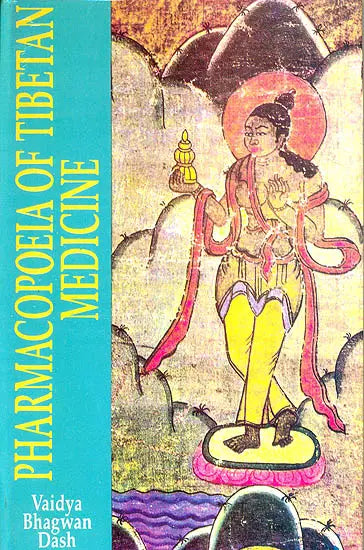Pharmacopoeia of Tibetan Medicine: No.17 (Indian Medical Science)
Pharmacopoeia of Tibetan Medicine: No.17 (Indian Medical Science) is backordered and will ship as soon as it is back in stock.
Couldn't load pickup availability
Genuine Products Guarantee
Genuine Products Guarantee
We guarantee 100% genuine products, and if proven otherwise, we will compensate you with 10 times the product's cost.
Delivery and Shipping
Delivery and Shipping
Products are generally ready for dispatch within 1 day and typically reach you in 3 to 5 days.
Book Title: Pharmacopoeia of Tibetan Medicine
Author: Vaidya Bhagwan Dash
Publisher: Sri Satguru Publications
Language: Tibetan Text with English Translation
Edition: 1994
ISBN: 9788170303886
Pages: 348
Cover: Hardcover
Dimensions: 23 cm x 15 cm
Weight: 500 gm
About the Book
About the Book
With increasing global awareness about Tibet's multi-dimensional culture—encompassing religion, philosophy, arts, and traditional medicine—Tibetan medicine has become a focus of interest for scholars, physicians, and the general public alike. However, the therapeutic knowledge within Tibetan texts is often difficult to access due to language barriers and the cryptic nature of the descriptions. To bridge this gap, this book compiles 205 popularly used and therapeutically effective recipes from Tibetan medical traditions. Each recipe is elaborated with details on its composition, ingredients, preparation methods, indications, dosage, and quality control, addressing the need for standardization in this field. This work is crucial for physicians practicing Tibetan medicine, Ayurveda, and modern medicine, as well as for scholars of Tibetology and Indology.
About the Author
Vaidya Bhagwan Dash is a distinguished scholar and practitioner in the field of Ayurveda with an impressive academic career spanning over three decades. He has participated in numerous international conferences and seminars, contributing significantly to the field with over forty publications. His comprehensive work on Tibetan and Ayurvedic medicine includes the Encyclopedia of Tibetan Medicine, a multi-volume reference.
Preface
The rising popularity of Tibetan medicine across Tibet, Bhutan, Mongolia, India’s northern regions, and beyond, underscores the importance of compiling a standard pharmacopoeia. This volume serves as a precursor to creating a standardized pharmacopoeia for single drugs and compound preparations used by Tibetan physicians. In this work, the author has expanded on a previously published formulary that included 164 recipes, now offering 205 in total. These recipes are sourced from authentic Tibetan medical texts and include both classical and more commonly used modern variants.
Mode of Arrangement
The recipes are categorized according to their pharmaceutical processes and are arranged alphabetically in Tibetan. The focus is primarily on powders and pills, with a few examples of decoctions, khandas, and medicated butter. In some cases, powders are also prepared in the form of pills, and vice versa. Minor discrepancies in the alphabetical order are acknowledged and explained in the text.
Description of Ingredients
The ingredients for each recipe are numbered and listed in a vertical column for easy reference. The names and parts used in the recipe are provided in Romanized form, with a Romanization table included for those unfamiliar with Tibetan script. The quantity of each ingredient required for a unit of the recipe is specified in metric measurements.
Methods of Preparation
General methods of preparation are outlined in the appendix, with special methods (Las thabs) detailed for each recipe.
Indications
Each recipe is associated with the ailments or conditions it is most commonly used to treat. These indications are an essential part of each entry, offering guidance on the therapeutic uses of the recipes.
Dose
The standard dosage (thun) for each recipe, as well as the time of administration, is provided for the reader's convenience.
Vehicles
Tibetan recipes are often combined with specific vehicles (sman rta), which are types of substances used in the administration of the medicine. These are indicated for each recipe along with any relevant precautions.
Introduction
Tibetan medicine, deeply rooted in ancient traditions, has always aimed to alleviate the three types of miseries: those arising from one's own body, from external factors, and from supernatural elements. The desire to live a long and healthy life is universal, and Tibetan medicine has developed over time to address this aspiration through the use of drugs, diet, and drinks. The traditional Tibetan system of medicine, known as "Gso ba rig" or "Tsh yi rig byed," is not only popular in Tibet but also in neighboring regions like Bhutan, Mongolia, and parts of India. Tibetan medicine blends folk traditions with classical Indian and Mongolian medical systems, making it both a practical and scholarly discipline.
Fundamentals of Drug Composition and Action
Tibetan medicine's unique approach to drug composition involves the concept of the "five basic elements" (sa, chu, me, rhun, and nam 'kha), which form the foundation of all matter, including drugs, diet, and the human body. These elements manifest in different forms in the body, and their interaction is considered essential when diagnosing diseases and prescribing treatments. The attributes of drugs, including their taste (ro), potency (nus pa), and properties (yon tan), are essential for understanding their therapeutic effects and ensuring the efficacy of Tibetan medical practices.





